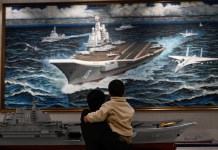The economic distress caused by the coronavirus has lead to several countries from Asia and Africa to seek delay or waive debt repayments for China’s billion-dollar Belt and Road Initiative (BRI).
Chinese Economy Can Collapse If Trillion Dollar BRI Corridor Fails – Experts
The situation has taken such a turn that China’s Premier Li Keqiang said on Friday at the start of the National People’s Congress (NPC), or the Chinese Parliament that “we will focus on quality in the joint pursuit of the BRI”.
The NPC report, one of the most crucial policy documents in China mentions a sub-section on the initiative since 2017, giving it a special status.
In 2019, the report said that saying China “will promote the joint pursuit of the BRI”. In contrast, the 2020 report purposefully mentions about “quality” and says that China would focus on “achieving shared growth through consultation and collaboration” and would “work with BRI partners for mutually beneficial outcomes”, omitting the lines that mentioned about China seeking to advance infrastructure connectivity.
About the concerns on the debts, Song Wei, deputy director at the Ministry of Commerce’s Chinese Academy of International Trade and Economic Cooperation wrote for the Communist Party-run Global Times that,“ “What China could do to help is bring projects funded by loans back to life and realise sustainable profits, instead of measures as simple as offering write-offs.”
He continues that “simply waiving debtors’ obligations as some countries or organizations have called for is not going to be effective as a solution. If any debtors encounter difficulties to pay on time, there may be tailored plans including rescheduling or China increasing funding to help related projects resume operation and return profits.”
It is noted that the world’s debt to China grew 10 times between 2000 and 2017 where the share by developing countries is as high as $380 billion. It is also reported that between 2000 and 2014, China’s grants and loans made a grand sum of $354.4 billion, out of which only 23% was grants and the remaining were commercial loans at the market or close-to-market rates.
Even after this humongous sum of debts, loans and grants, the Chinese official suggests that the problem of repayments could be solved “by multiple financial or other approaches, such as China adding grants to help bring projects back to life, conducting debt-to-equity swaps, or hiring Chinese firms to assist operation”.
Originally, China’s Belt and Road Initiative (BRI) was launched in 2013 with a development strategy aimed to build connectivity across six main economic corridors that consisted of about 130 countries.
The OECD Business and Finance Outlook mentioned that “mutual benefit is a feature of the BRI which will also help to develop markets for China’s products in the long term and to alleviate industrial excess capacity in the short term.”
Hailed as one of the greatest projects undertaken by China, the World Bank had estimated that more than half a trillion dollars of BRI projects had been planned, were underway or already complete. However, experts on the sector such as Fitch Solutions wrote in a research paper last month that “Progress of China’s BRI infrastructure projects will hit a roadblock due to the ongoing . . . pandemic,”
“As the global economy sinks into a recession, BRI countries, especially frontier markets, are unlikely to take on fresh debt to finance new projects in the near term,” it added.
Originally Penned by Ananth Krishnan. Edited By Vipasha Kaushal




